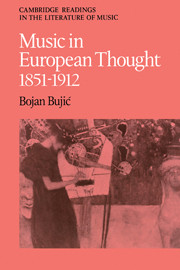Book contents
- Frontmatter
- Contents
- Preface
- Acknowledgments
- List of abbreviations
- General introduction
- Part I German aesthetics of music in the second half of the nineteenth century
- Part 2 Aesthetics of music in France and England
- Part 3 Music and positivist thought
- Part 4 Bridge between music theory and philosophy and the beginnings of musicology as an independent discipline
- Part 5 New tendencies at the turn of the century
- Select bibliography
- Index
Part 4 - Bridge between music theory and philosophy and the beginnings of musicology as an independent discipline
Published online by Cambridge University Press: 05 February 2012
- Frontmatter
- Contents
- Preface
- Acknowledgments
- List of abbreviations
- General introduction
- Part I German aesthetics of music in the second half of the nineteenth century
- Part 2 Aesthetics of music in France and England
- Part 3 Music and positivist thought
- Part 4 Bridge between music theory and philosophy and the beginnings of musicology as an independent discipline
- Part 5 New tendencies at the turn of the century
- Select bibliography
- Index
Summary
Introduction
The ingredients for a systematic study of music in all of its aspects – historical, technical, theoretical, aesthetic – existed before, in some cases well before the nineteenth century, but at no other time in history were conditions so favourable for such a study as was the case during the middle of the nineteenth century. The initiative did not come from the musicians themselves. The romantic image of a lonely, suffering and rebellious artist and the divinely inspired virtuoso performer did not go towards helping a dispassionate study. Indeed, the image clashed with the enquiring spirit of historical study and the increasing application of scientific method in psychology and positivist sociology. It became increasingly apparent that the positivist step-by-step investigation could be applied in order to counter and de-mystify this romantic attitude. The actual task of formulating a programme for a systematic study came from those scholars who occupied the middle ground between philosophical speculation and scientific rigour or, to put it differently, from those whose traditional humanistic learning was influenced by the positivist manner of defining the scope of a discipline and devising sub-disciplines and categories.
Although, as mentioned earlier, positivism in the narrow sense was largely a French phenomenon, positivist attitude to science and philosophy was powerfully felt in Germany and, taking into consideration the weight of German historiography and philosophy, it is not surprising to see that the programme of a systematic study of music was largely a German phenomenon.
- Type
- Chapter
- Information
- Music in European Thought 1851–1912 , pp. 339 - 362Publisher: Cambridge University PressPrint publication year: 1988

